Research on Structural Performance of Hybrid Ferro Fiber Reinforced Concrete Slabs
Abstract
:1. Introduction
2. Materials and Methods
2.1. Cement
2.2. Fine Aggregate
2.3. Coarse Aggregate
2.4. Water
2.5. Silica Fume (SF)
2.6. Polypropylene Fibers
2.7. Steel Reinforcing Mesh
2.8. Steel Reinforcement
2.9. Specimen Preparation
2.10. Experimental Procedure and Testing of Flexural Specimens
3. Results and Discussions
3.1. Compressive Strength of Mortar Cubes
3.2. First Cracking and Ultimate Failure Load of Slab Specimens
3.3. Ductility Ratio
3.4. Load Deflection Response
3.5. Stress-Strain Response
3.6. Energy Absorbed
3.7. Crack Pattern
4. Conclusions
- Replacement of cement with 10% SF and adding PPF in cubes enhanced the compressive strength, with the maximum percentage recorded as 37.11% with 0.50% polypropylene fibers. SF improved the dispersion of PPF and increased the compressive strength through an improved bond between cement paste and aggregates.
- First cracking and ultimate loads depended on the number of wire mesh layers in ferrocement slabs.
- Higher numbers of wire meshes and their uniform distribution along the thickness of ferro cement slabs resulted in more ductility. This resulted in more cracks with reduced width.
- A comparative study of the first cracking load showed that adding PPF and reinforcement optimization in ferrocement slabs (four meshes, 0.50% PPF and 10% of SF) resulted in 15.25% higher values than the control slab.
- Increasing strain at peak stress and extended length of descending branch for the stress-strain curve was observed with an increased percentage of polypropylene fibers in the mixture.
- A similar increasing trend of 24.33% was observed for the energy absorption capacity of ferrocement slabs (four meshes, 0.30% PPF and 10% SF), proving enhanced ductile behavior and superiority in crack control for ferrocement slabs.
- A comparative study of deflection behavior showed that ferrocement slabs (four meshes, 0.30% PPF and 10% of SF) experienced a maximum of 13.56% more deflection than the control slab, exhibiting good ductility. Similarly, the percentage increase in strain observed with ferrocement slabs was 21.05% more than that of the control slab.
- The ductility ratio for ferrocement slabs showed the highest value of 1.77 in the case of F4MB1PPF-S and the least value of 1.16 for F1MC1PPF-S. The increasing trend was due to the increased % Vr of reinforcement mesh.
- Further research can be done to study the influence of mesh opening, mortar layer thickness and section depth on the flexural behavior of ferrocement slabs.
- More experimental work is required to study the flexural behavior of reinforced ferrocement slabs with other mesh types. The most economical type of mesh optimization study can then be carried out. Moreover, the durability aspects of selecting a curing technique and its optimum duration must be explored.
- Further experimental works are needed to explore the feasibility of using recycled aggregates instead of natural coarse aggregate concrete.
- SEM studies need to be conducted to better understand the binary action of SF and PPF on the concrete internal pores filling mechanism.
- Finite element analysis (FEA) and parametric study for investigating the effects of concrete strength and cover on the load carrying capacity and ductility performance of hybrid ferro fiber reinforced concrete slabs.
Author Contributions
Funding
Institutional Review Board Statement
Informed Consent Statement
Data Availability Statement
Acknowledgments
Conflicts of Interest
References
- Mukherjee, S.; Vesmawala, G. Literature review on technical aspect of sustainable concrete. Int. J. Eng. Sci. Invent. 2013, 2, 1–9. [Google Scholar]
- Choi, Y.; Yuan, R.L. Experimental relationship between splitting tensile strength and compressive strength of GFRC and PFRC. Cem. Concr. Res. 2005, 35, 1587–1591. [Google Scholar] [CrossRef]
- Vatin, N.I.; Murali, G.; Abid, S.R.; de Azevedo, A.R.G.; Tayeh, B.A.; Dixit, S. Enhancing the Impact Strength of Prepacked Aggregate Fibrous Concrete Using Asphalt-Coated Aggregates. Materials 2022, 15, 2598. [Google Scholar] [CrossRef]
- Verma, A.; Shukla, M.; Sahu, A. Performance of fly ash and stone dust blended concrete in acidic environment. Concr. Res. Lett. 2013, 4, 476–569. [Google Scholar]
- Amran, M.; Fediuk, R.; Murali, G.; Avudaiappan, S.; Ozbakkaloglu, T.; Vatin, N.; Karelina, M.; Klyuev, S.; Gholampour, A. Fly ash-based eco-efficient concretes: A comprehensive review of the short-term properties. Materials 2021, 14, 4264. [Google Scholar] [CrossRef] [PubMed]
- Bayramov, F.; Taşdemir, C.; Taşdemir, M. Optimisation of steel fibre reinforced concretes by means of statistical response surface method. Cem. Concr. Compos. 2004, 26, 665–675. [Google Scholar] [CrossRef]
- Hossain, M.Z.; Rokonuzzaman, M.; Inoue, S. Flexural behavior of cement composites panels reinforced with different types of meshes. In Proceedings of the 30th Conference on Our World in Concrete & Structures, Singapore, 23–24 August 2005; pp. 23–24. [Google Scholar]
- Naaman, A.E. Ferrocement and Laminated Cementitious Composites; Techno Press: Ann Arbor, MI, USA, 2000. [Google Scholar]
- Ibrahim, H.M. Experimental investigation of ultimate capacity of wired mesh-reinforced cementitious slabs. Constr. Build. Mater. 2011, 25, 251–259. [Google Scholar] [CrossRef]
- Alnuaimi, A.; Hago, A.; Al-Jabri, K. Flexural behaviour of ferrocement roof panels. In WIT Transactions on the Built Environment; WIT Press: Southampton, UK, 2006; Volume 85. [Google Scholar]
- Mughal, U.A.; Saleem, M.A.; Abbas, S. Comparative study of ferrocement panels reinforced with galvanized iron and polypropylene meshes. Constr. Build. Mater. 2019, 210, 40–47. [Google Scholar] [CrossRef]
- Sakthivel, P.; Jagannathan, A. Study on Flexural behaviour of ferrocement slabs reinforced with PVC-coated weld mesh. Int. J. Eng. Res. Dev. 2012, 1, 50–57. [Google Scholar]
- Muhammed, H.S.; Al Abdaly, N.M.; Zeini, H.A.; Saeed, A.H. Use of polypropylene ropes in concrete to minimize steel reinforcement. Period. Eng. Nat. Sci. (PEN) 2019, 7, 1904–1914. [Google Scholar] [CrossRef]
- Batson, G. Ferrocement and laminated cementitious composites. Mater. Struct. 2000, 33, CO3. [Google Scholar] [CrossRef]
- Prasad, N.; Murali, G. Exploring the impact performance of functionally-graded preplaced aggregate concrete incorporating steel and polypropylene fibres. J. Build. Eng. 2021, 35, 102077. [Google Scholar] [CrossRef]
- Sathish Kumar, V.; Ganesan, N.; Indira, P.V.; Murali, G.; Vatin, N.I. Behaviour of Hybrid Fibre-Reinforced Ternary Blend Geopolymer Concrete Beam-Column Joints under Reverse Cyclic Loading. Polymers 2022, 14, 2239. [Google Scholar] [CrossRef] [PubMed]
- Lin, V.W.J.; Quek, S.T.; Maalej, M. Static and dynamic tensile behaviour of PE-fibrous ferrocement. Mag. Concr. Res. 2011, 63, 61–73. [Google Scholar] [CrossRef]
- Shannag, M.J.; Ziyyad, T.B. Flexural response of ferrocement with fibrous cementitious matrices. Constr. Build. Mater. 2007, 21, 1198–1205. [Google Scholar] [CrossRef]
- Wang, S.; Naaman, A.E.; Li, V.C. Bending response of hybrid ferrocement plates with meshes and fibers. In Proceedings of the 7th International Symposium on Ferrocement and Thin Reinforced Cement Composites, Singapore, 27–29 June 2006. [Google Scholar]
- Murali, G.; Prasad, N.; Abid, S.R.; Vatin, N.I. Response of Functionally Graded Preplaced Aggregate Fibrous Concrete with Superior Impact Strength. Buildings 2022, 12, 563. [Google Scholar] [CrossRef]
- Toutanji, H.A.; El-Korchi, T. The influence of silica fume on the compressive strength of cement paste and mortar. Cem. Concr. Res. 1995, 25, 1591–1602. [Google Scholar] [CrossRef]
- Sakir, S.; Raman, S.; Kaish, A.; Mutalib, A. Self-flowing mortar for ferrocement in strengthening applications. Perspect. Sci. 2016, 8, 673–676. [Google Scholar] [CrossRef]
- Kaish, A.; Jamil, M.; Raman, S.; Zain, M.; Alam, M. An approach to improve conventional square ferrocement jacket for strengthening application of short square RC column. Mater. Struct. 2016, 49, 1025–1037. [Google Scholar] [CrossRef]
- Işıkdağ, B. Characterization of lightweight ferrocement panels containing expanded perlite-based mortar. Constr. Build. Mater. 2015, 81, 15–23. [Google Scholar] [CrossRef]
- Nagan, S.; Mohana, R. Behaviour of geopolymer ferrocement slabs subjected to impact. Iran. J. Sci. Technol. Trans. Civ. Eng. 2014, 38, 223. [Google Scholar]
- Mashrei, M. Effects of steel fibres and silica fume on the behaviours of square ferrocement slabs under flexural loading. In Proceedings of IOP Conference Series: Materials Science and Engineering; IOP Publishing: Bristol, UK, 2018; Volume 433, p. 012025. [Google Scholar]
- Mohamed, O.A.; Syed, Z.I.; Najm, O.F. Splitting tensile strength of sustainable self-consolidating concrete. Procedia Eng. 2016, 145, 1218–1225. [Google Scholar] [CrossRef]
- Murali, G.; Amran, M.; Fediuk, R.; Vatin, N.; Raman, S.N.; Maithreyi, G.; Sumathi, A. Structural Behavior of Fibrous-Ferrocement Panel Subjected to Flexural and Impact Loads. Materials 2020, 13, 5648. [Google Scholar] [CrossRef] [PubMed]
- Naik, T.R.; Singh, S.S. Superplasticized structural concrete containing high volume of class C fly ash. J. Energy Eng. 1991, 117, 87–96. [Google Scholar] [CrossRef] [Green Version]
- Quercia, G.; Spiesz, P.; Hüsken, G.; Brouwers, H. SCC modification by use of amorphous nano-silica. Cem. Concr. Compos. 2014, 45, 69–81. [Google Scholar] [CrossRef]
- El-Chabib, H.; Syed, A. Properties of self-consolidating concrete made with high volumes of supplementary cementitious materials. J. Mater. Civ. Eng. 2012, 25, 1579–1586. [Google Scholar] [CrossRef]
- Saleem, M.; Ashraf, M. Low cost earthquake resistant ferrocement small house. Pak. J. Eng. Appl. Sci. 2016, 2, 59–64. [Google Scholar]
- Paramasivam, P. Ferrocement structural applications. In Proceedings of the Singapore 26th Conference on Our World in Concrete & Structures, National University of Singapore, Singapore, 27–28 August 2001. [Google Scholar]
- Ali, Z.M.; Hama, S.M.; Mohana, M.H. Flexural behavior of one-way ferrocement slabs with fibrous cementitious matrices. Period. Eng. Nat. Sci. (PEN) 2020, 8, 1614–1624. [Google Scholar]
- Shayma’a, A.M. Sphrical Slab with Ferrocement. Eng. Technol. J. 2011, 29, 2609–2616. [Google Scholar]
- Abushawashi, N.F.O.; Vimonsatit, V. Influence of mixture, wire mesh and thickness on the flexural performance of hybrid PVA fibre ferrocement panels. Int. J. Innov. Res. Sci. Eng. Technol. 2014, 3, 15805–15812. [Google Scholar] [CrossRef]
- Phalke, R.J.; Gaidhankar, D.G. Flexural behaviour of ferrocement slab panels using welded square mesh by incorporating steel fibres. Int. J. Res. Eng. Technol. 2014, 3, 756–763. [Google Scholar]
- Phiske, K.A.; Gaidhankar, D.G. Comparative Study of Ferro-Cement Panel Using Welded Square Mesh and Expanded Mesh. Int. J. Innov. Sci. Eng. Technol. 2015, 2, 594–597. [Google Scholar]
- Sasiekalaa, K.; Malathy, R. Flexural Performance of Ferro cement laminates containing silca fume and fly ash reinforced with chicken mesh. Int. J. Civ. Eng. Technol. (IJCIET) 2012, 3, 130–143. [Google Scholar]
- Memon, N.A.; Sumadi, S.R.; Ramli, M. Strength and behaviour of lightweight ferrocementaerated concrete sandwich blocks. Malays. J. Civ. Eng. 2006, 18. [Google Scholar] [CrossRef]
- Fahmy, E.H.; SHAHEEN, Y.I.; Korany, Y.S. Repairing reinforced concrete beams by ferrocement. J. Ferrocem. 1997, 27, 19–32. [Google Scholar]
- Romualdi, J.P. Ferrocement: Applications in Developing Countries; National Academy of Sciences: Washington, DC, USA, 1973. [Google Scholar]
- C150/C150M-12; Standard Specification for Portland Cement. ASTM International: West Conshohocken, PA, USA, 2012.
- C136-06; Standard Test Method for Sieve Analysis of Fine and Coarse Aggregates. ASTM International: West Conshohocken, PA, USA, 2006.
- C128-04a; Standard Test Method for Density, Relative Density (Specific Gravity), and Absorption of Fine Aggregate. ASTM International: West Conshohocken, PA, USA, 2017.
- C127-04; Standard Test Method for Specific Gravity and Absorption of Coarse Aggregate. ASTM International: West Conshohocken, PA, USA, 2004.
- 29/C 29M-97; Standard Test Method for Bulk Density (“Unit Weight”) and Voids in Aggregates. ASTM International: West Conshohocken, PA, USA, 1999.
- ASTM A 615/A 615M; Standard Specification for Deformed and Plain Carbon Steel Bars for Concrete Reinforcement. ASTM International: West Conshohocken, PA, USA, 2022.
- ACI Detailing Manual. ACI Committee 315. Publication SP-66 (94); American Concrete Institute: Detroit, MI, USA, 1994. [Google Scholar]
- Nili, M.; Afroughsabet, V. The effects of silica fume and polypropylene fibers on the impact resistance and mechanical properties of concrete. Constr. Build. Mater. 2010, 24, 927–933. [Google Scholar] [CrossRef]
- Mohamed, O. Durability and Compressive Strength of High Cement Replacement Ratio Self-Consolidating Concrete. Buildings 2018, 8, 153. [Google Scholar] [CrossRef]
- Mohamed, O.A.; Najm, O.F. Compressive strength and stability of sustainable self-consolidating concrete containing fly ash, silica fume, and GGBS. Front. Struct. Civ. Eng. 2017, 11, 406–411. [Google Scholar] [CrossRef]
- Batson, G.B.; Castro, J.O.; Guerra, A.J.; Iorns, M.E.; Johnston, C.D.; Naaman, A.E.; Romualdi, J.P.; Shah, S.P.; Zollo, R.F.; Swamy, N. Guide for the design, construction, and repair of ferrocement. ACI Struct. J. 1988, 85, 325–351. [Google Scholar]
- EN 196-1:2005; Methods of Testing Cementno. SIST: Ljubljana, Slovenia, 2005.
- BS 1881-116:1983; Method for Determination of Compressive Strength of Concrete Cubes. Institutions, B.S.: London, UK, 2003.
- C78–02; Standard Method for Flexural Strength of Concrete. ASTM International: West Conshohocken, PA, USA, 2002.
- Ramezanianpour, A.; Esmaeili, M.; Ghahari, S.-A.; Najafi, M. Laboratory study on the effect of polypropylene fiber on durability, and physical and mechanical characteristic of concrete for application in sleepers. Constr. Build. Mater. 2013, 44, 411–418. [Google Scholar] [CrossRef]
- Richardson, A.E. Compressive strength of concrete with polypropylene fibre additions. Struct. Surv. 2006, 24, 138–153. [Google Scholar] [CrossRef]
- Yoo, D.-Y.; Banthia, N. Mechanical properties of ultra-high-performance fiber-reinforced concrete: A review. Cem. Concr. Compos. 2016, 73, 267–280. [Google Scholar] [CrossRef]
- Fu, Q.; Niu, D.; Zhang, J.; Huang, D.; Wang, Y.; Hong, M.; Zhang, L. Dynamic compressive mechanical behaviour and modelling of basalt–polypropylene fibre-reinforced concrete. Arch. Civ. Mech. Eng. 2018, 18, 914–927. [Google Scholar] [CrossRef]
- Karimipour, A.; Ghalehnovi, M.; De Brito, J.; Attari, M. The effect of polypropylene fibres on the compressive strength, impact and heat resistance of self-compacting concreten. Structures 2020, 25, 72–87. [Google Scholar] [CrossRef]
- Fallah-Valukolaee, S.; Nematzadeh, M. Experimental study for determining applicable models of compressive stress–strain behavior of hybrid synthetic fiber-reinforced high-strength concrete. Eur. J. Environ. Civ. Eng. 2020, 24, 34–59. [Google Scholar] [CrossRef]
- Alsadey, S.; Salem, M. Influence of polypropylene fiber on strength of concrete. Am. J. Eng. Res. 2016, 5, 223–226. [Google Scholar]
- Roesler, J.R.; Altoubat, S.A.; Lange, D.A.; Rieder, K.-A.; Ulreich, G.R. Effect of synthetic fibers on structural behavior of concrete slabs-on-ground. ACI Mater. J. 2006, 103, 3. [Google Scholar]
- Yi, Z.; Li, Z.; Yang, Q.; Deng, W.; Ma, Y. Crack arresting mechanism of fiber reinforced concrete. In WIT Transactions on Engineering Sciences; WIT Press: Southampton, UK, 2004; Volume 47. [Google Scholar]
- Yap, S.P.; Alengaram, U.J.; Jumaat, M.Z. Enhancement of mechanical properties in polypropylene–and nylon–fibre reinforced oil palm shell concrete. Mater. Des. 2013, 49, 1034–1041. [Google Scholar] [CrossRef]
- Hago, A.; Al-Jabri, K.; Alnuaimi, A.; Al-Moqbali, H.; Al-Kubaisy, M. Ultimate and service behavior of ferrocement roof slab panels. Constr. Build. Mater. 2005, 19, 31–37. [Google Scholar] [CrossRef]
- Lakshmi, A.; Pandit, P.; Bhagwat, Y.; Nayak, G. A Review on Efficiency of Polypropylene Fiber-Reinforced Concrete. In Sustainability Trends and Challenges in Civil Engineering; Elsevier: Amsterdam, The Netherlands, 2022; pp. 799–812. [Google Scholar]
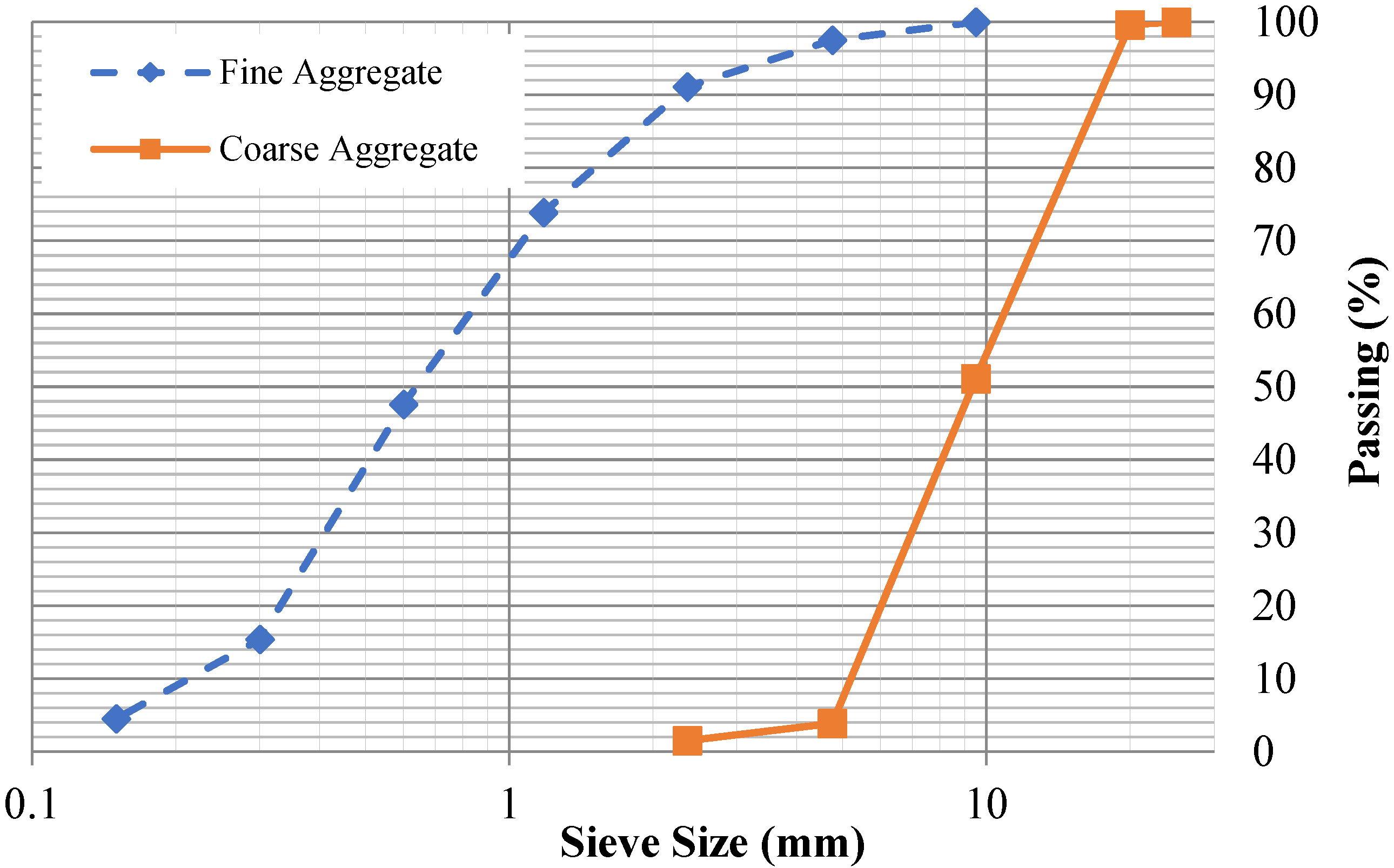


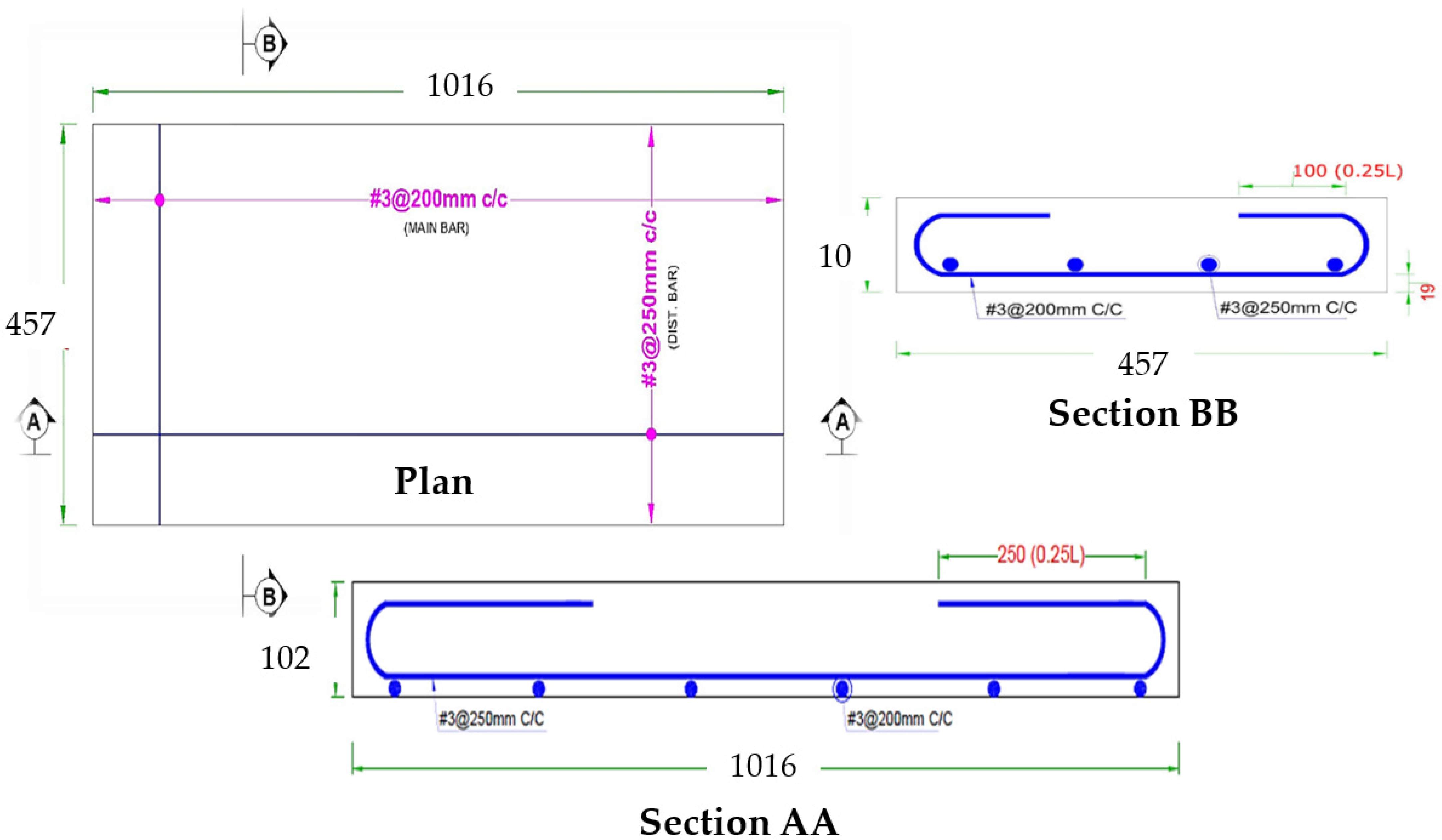
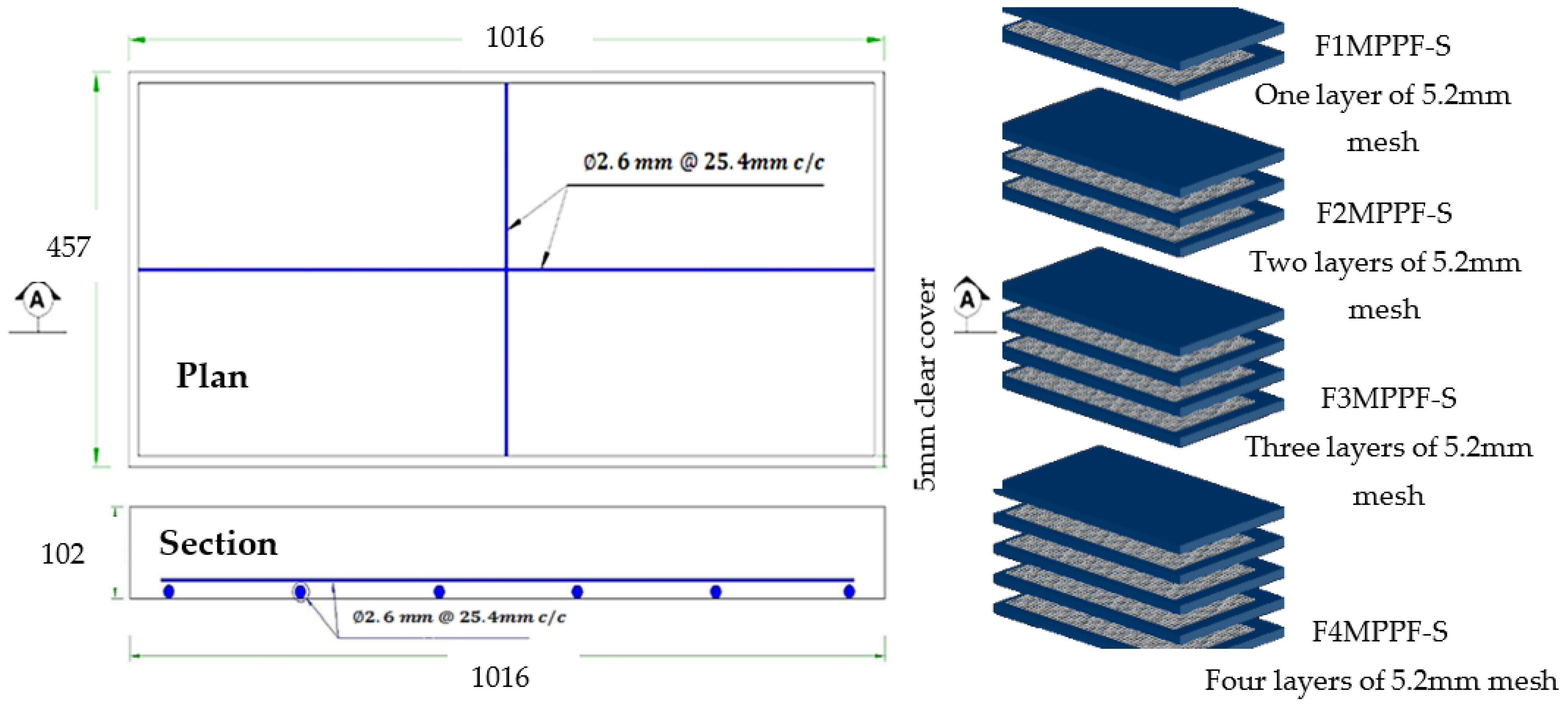
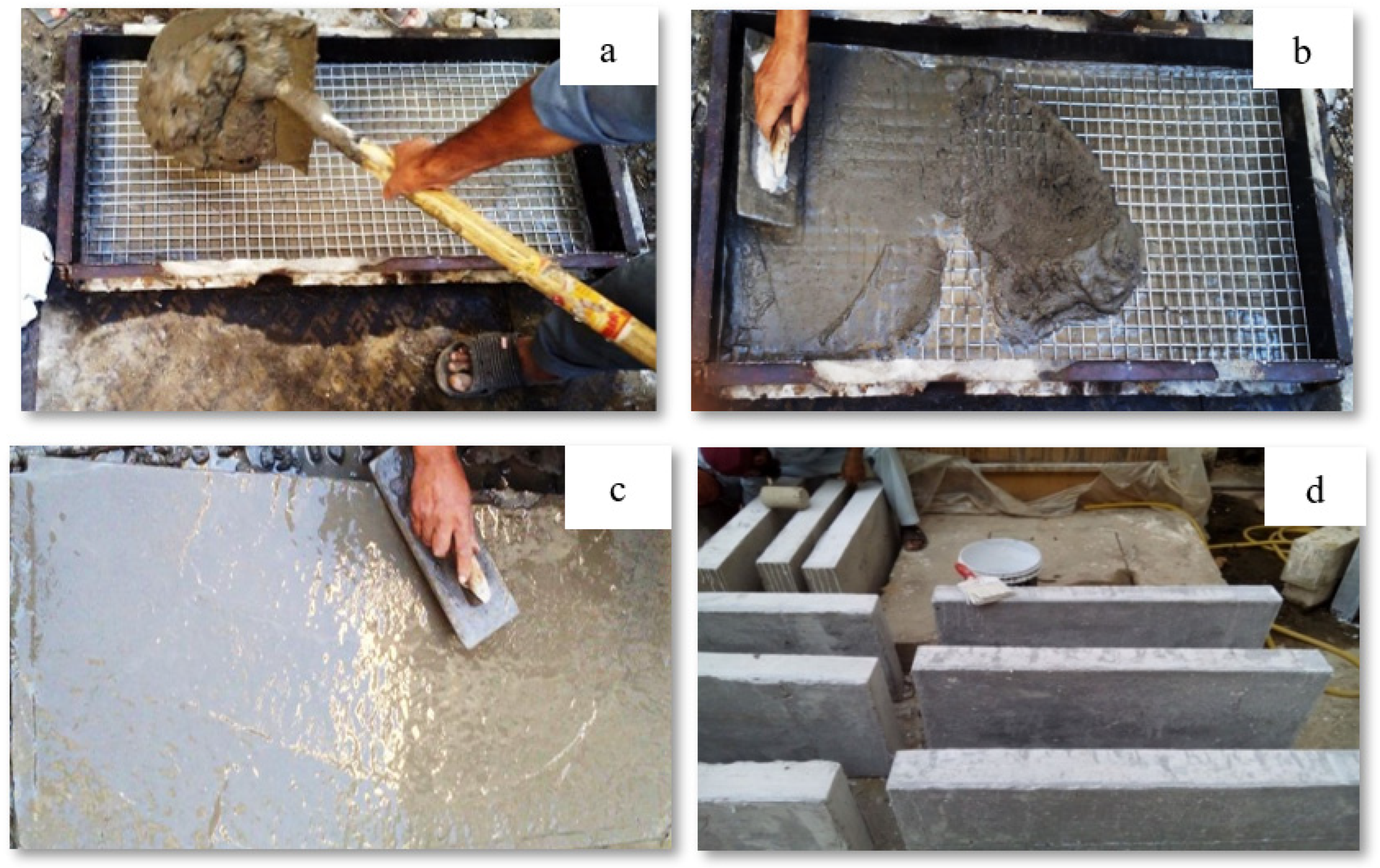
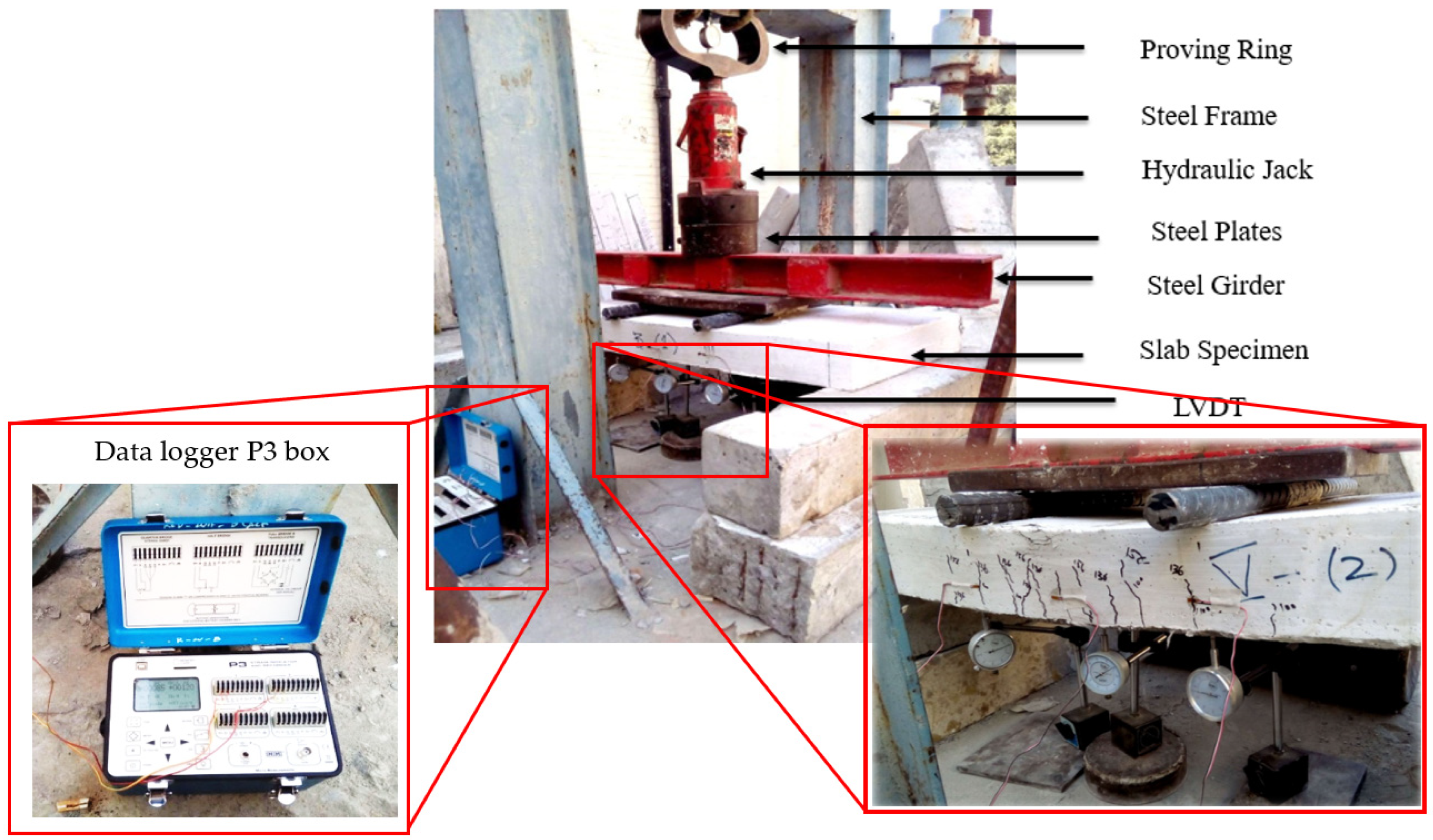

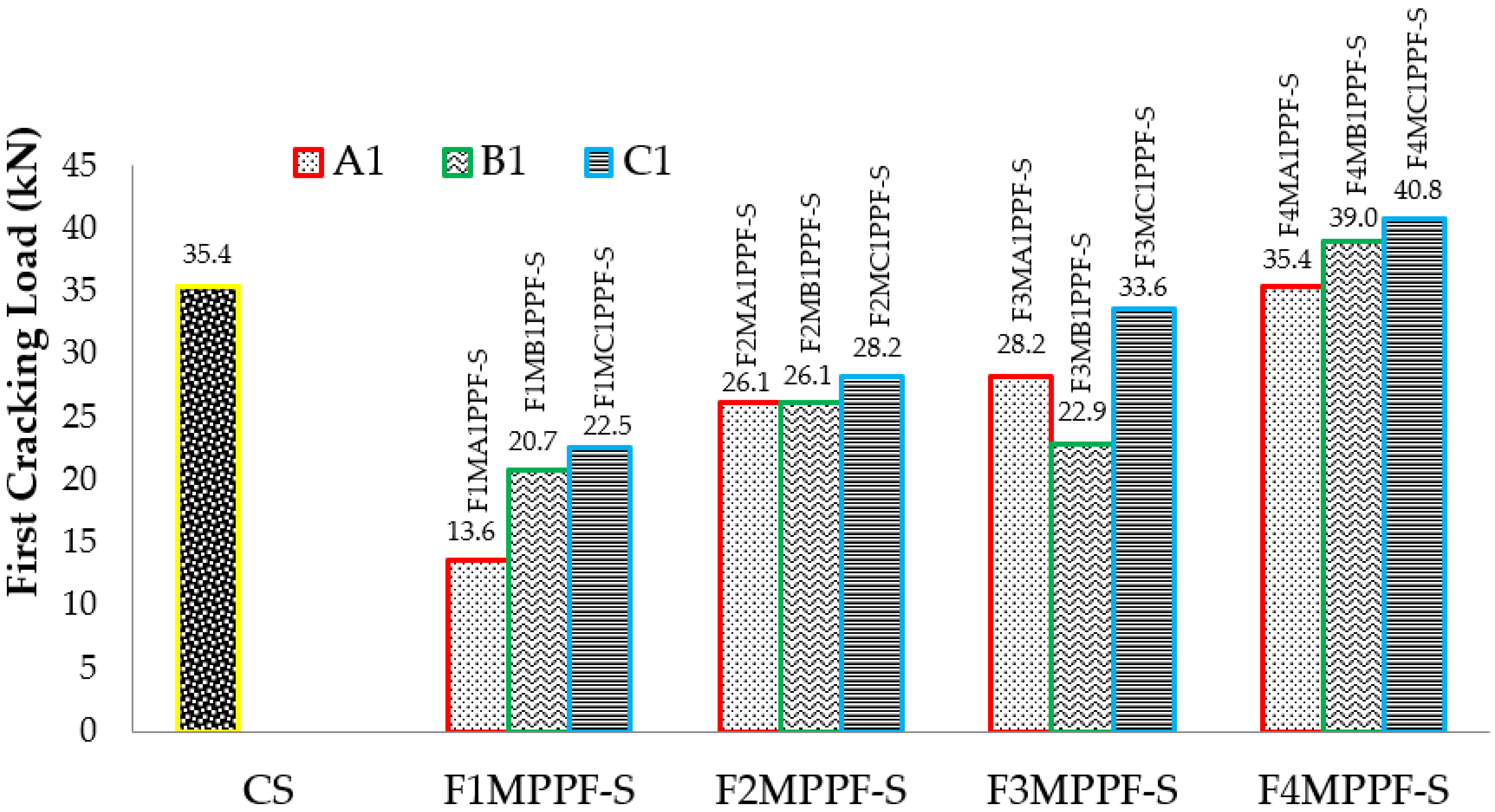
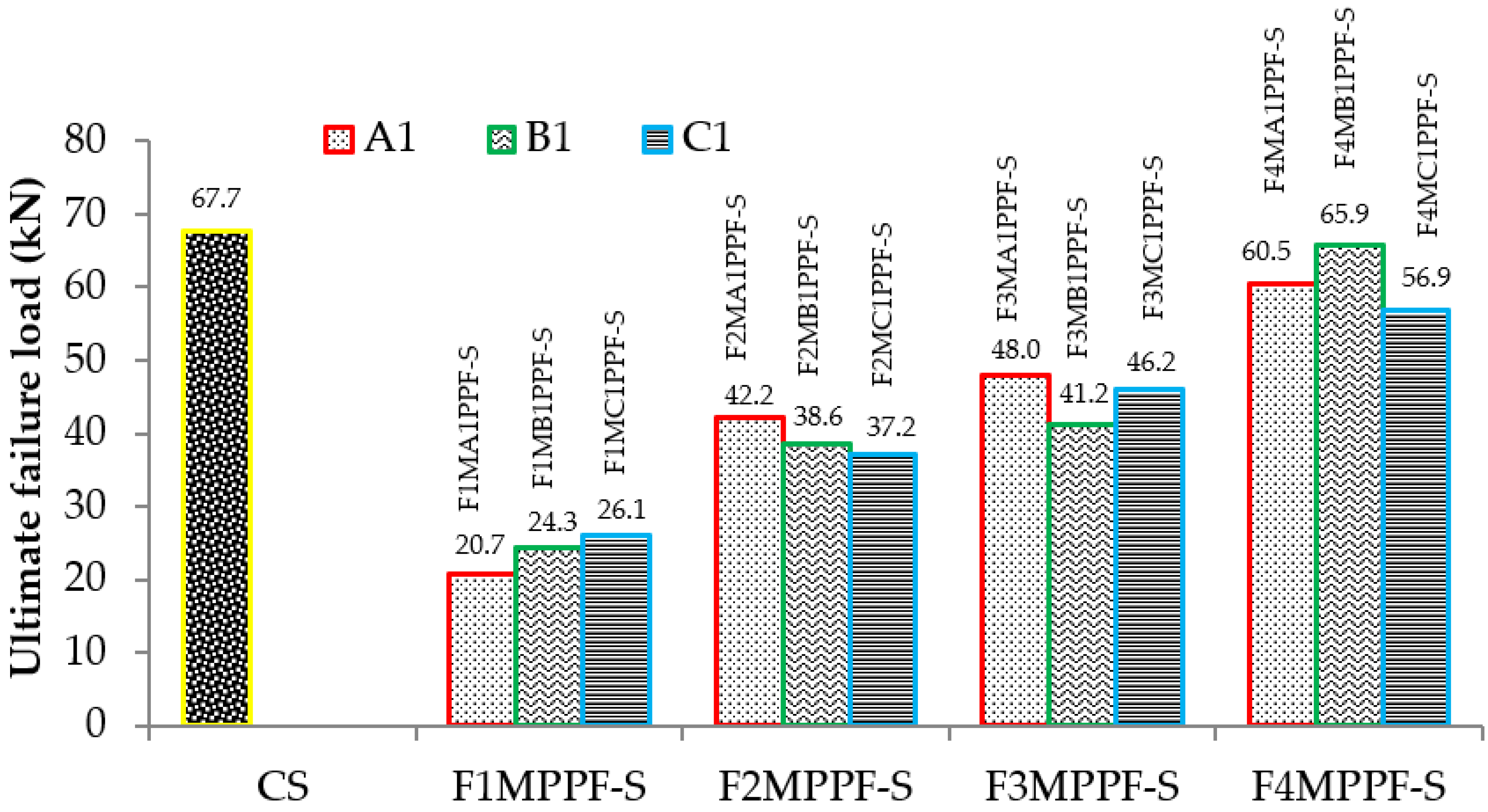
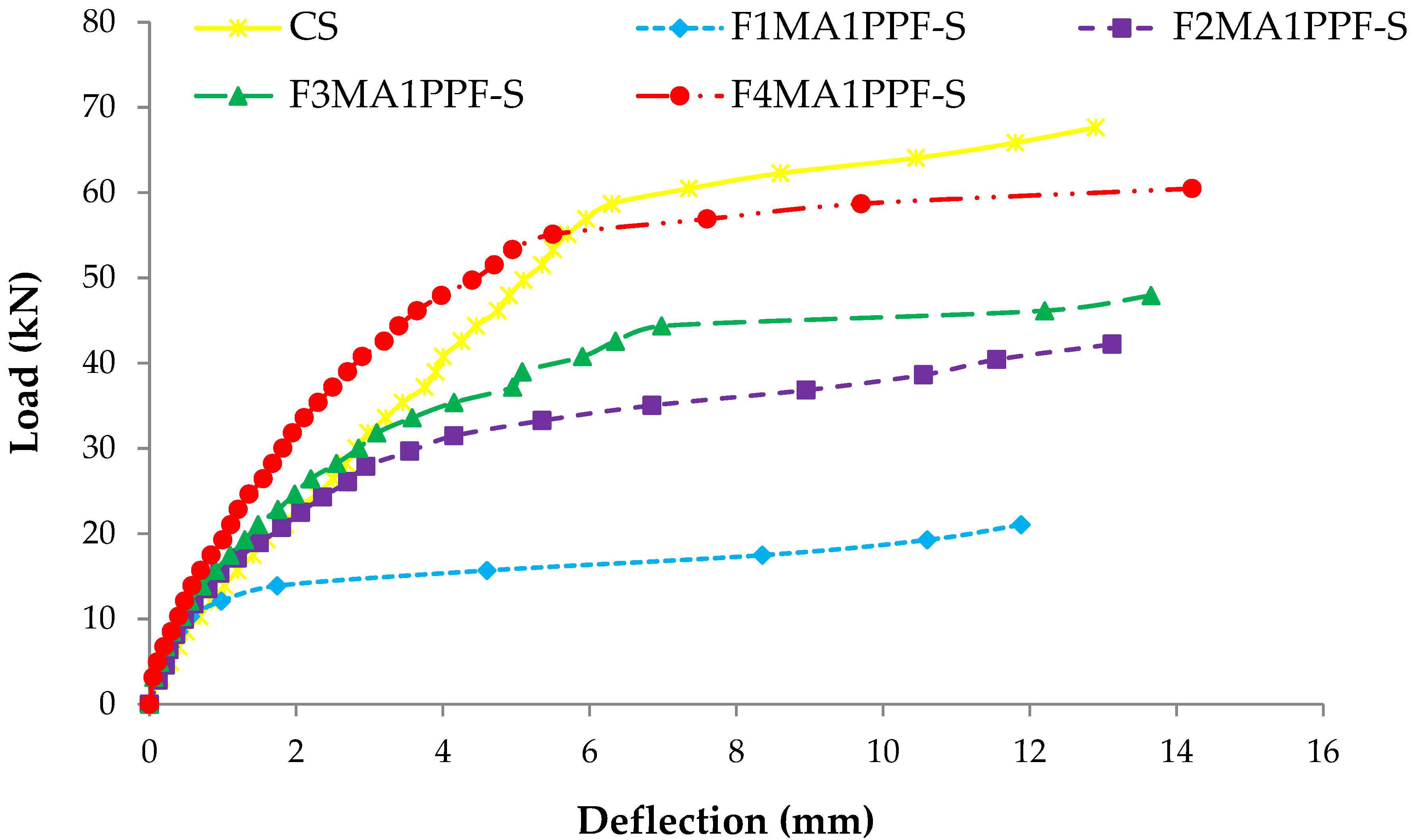

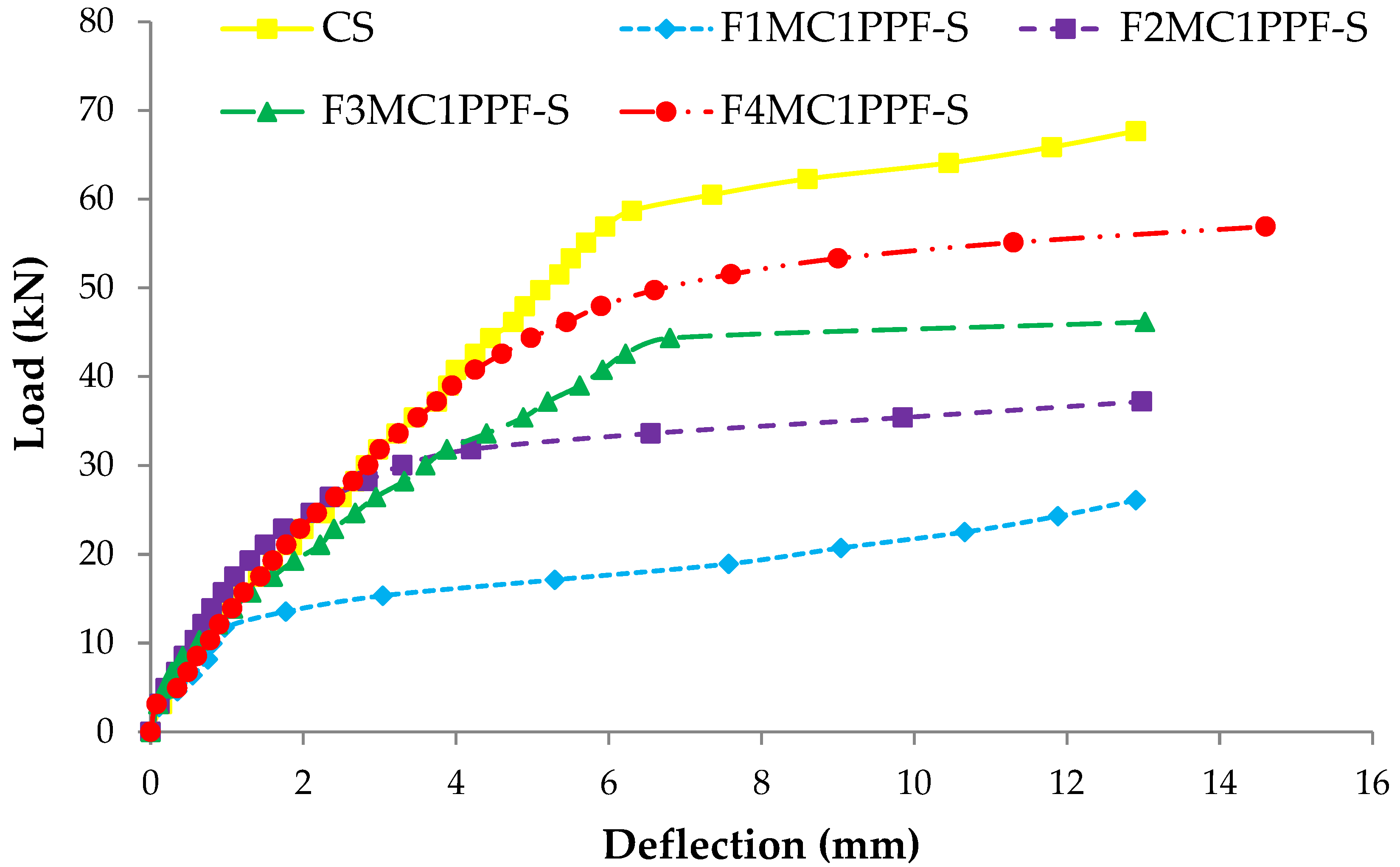
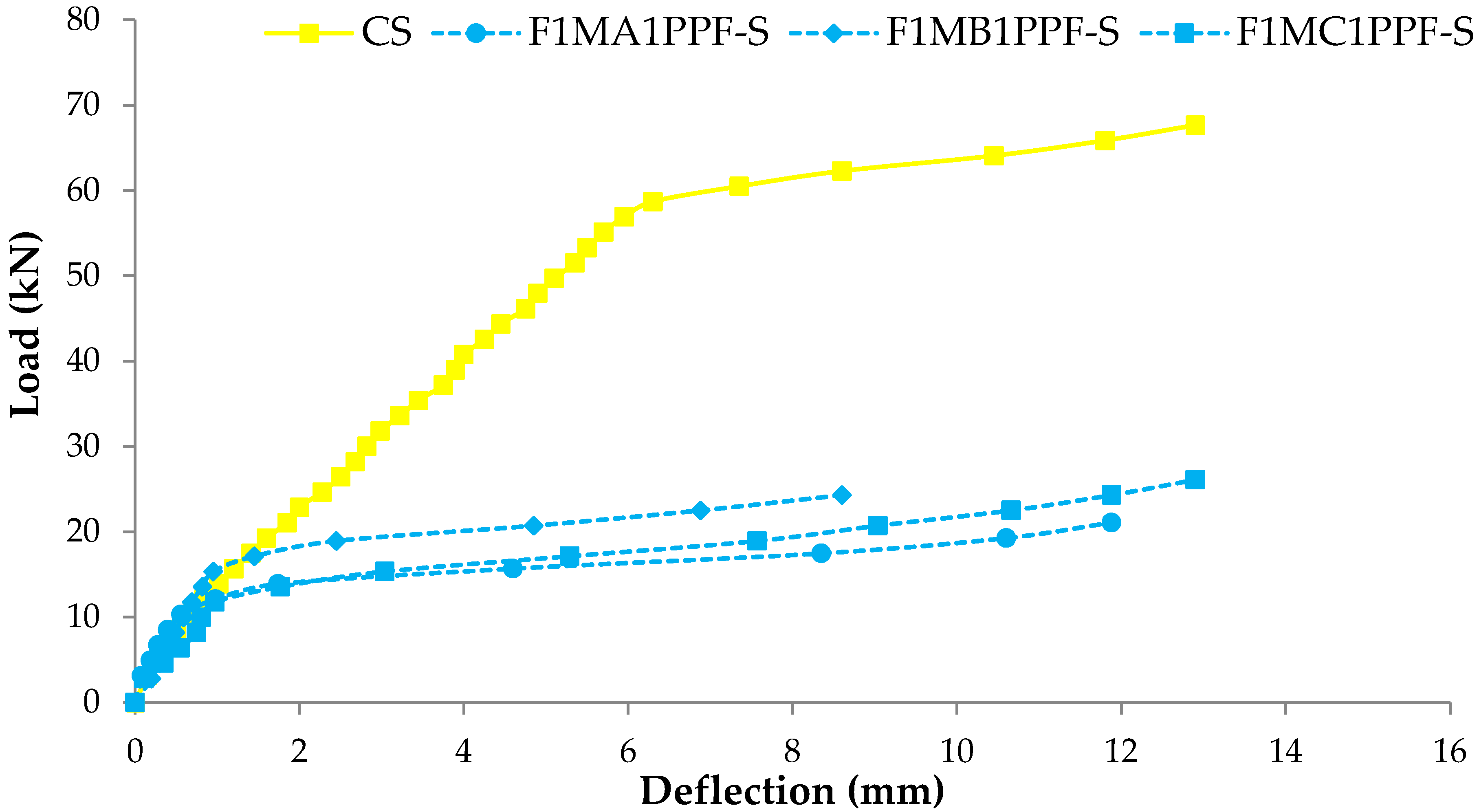
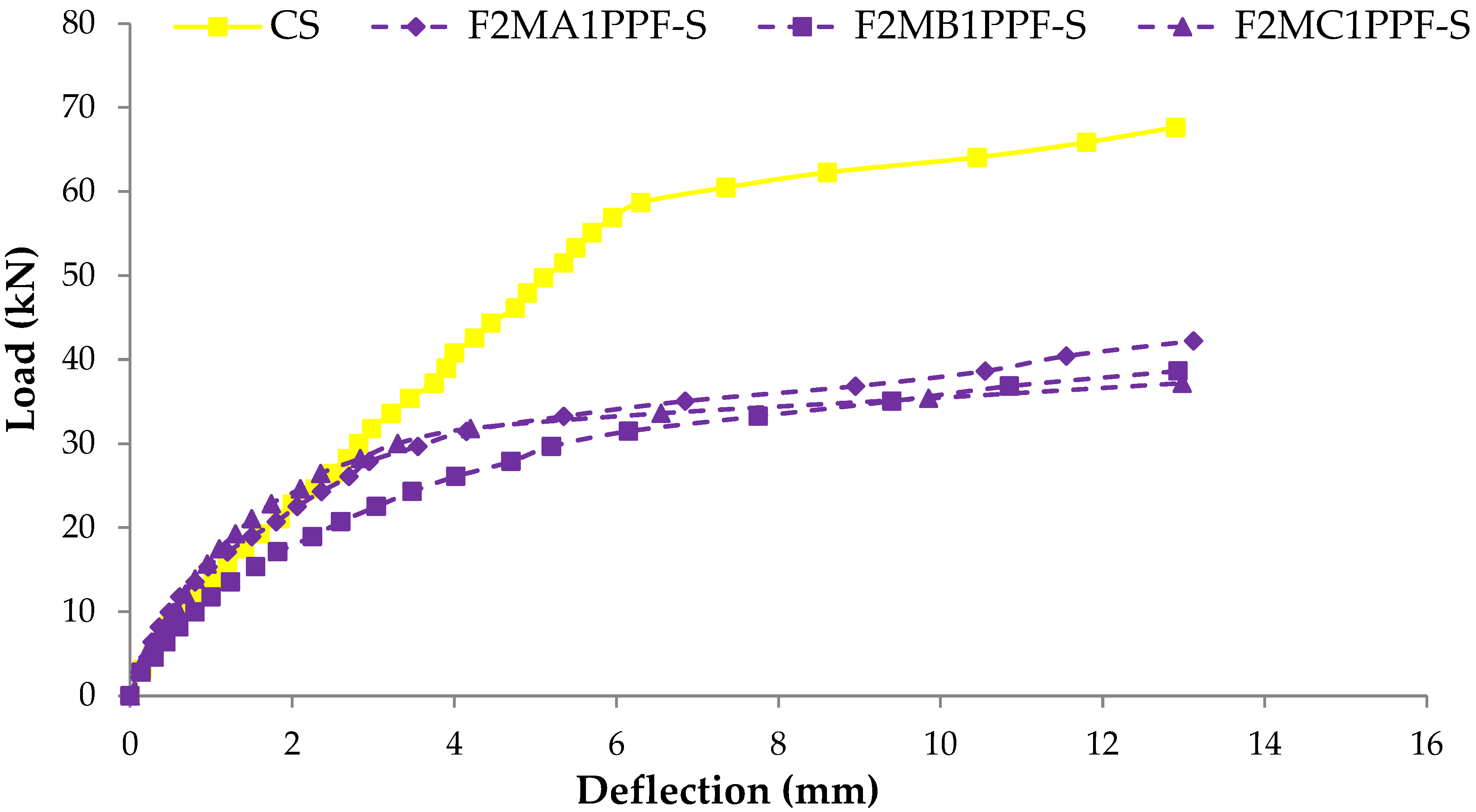
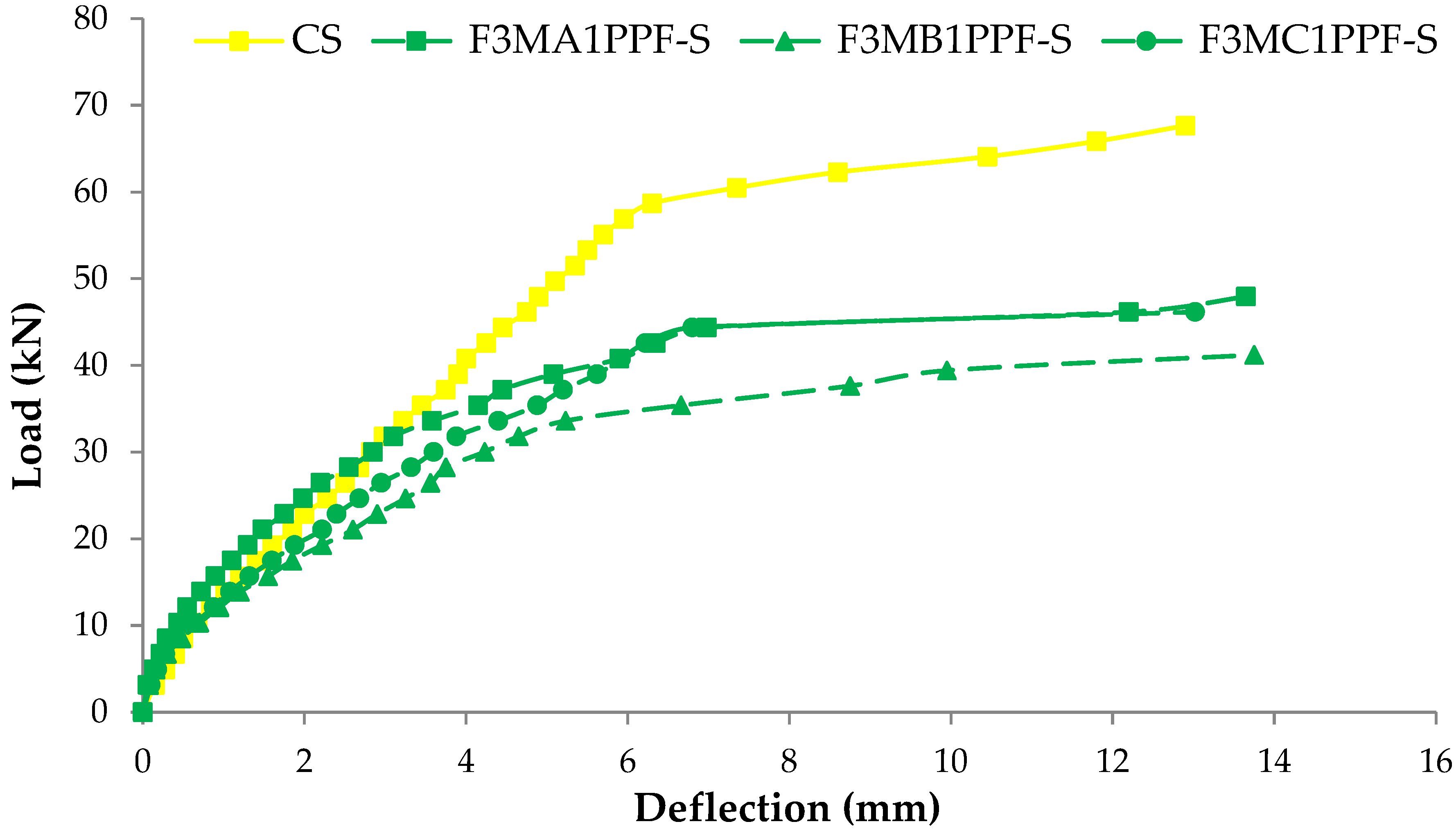
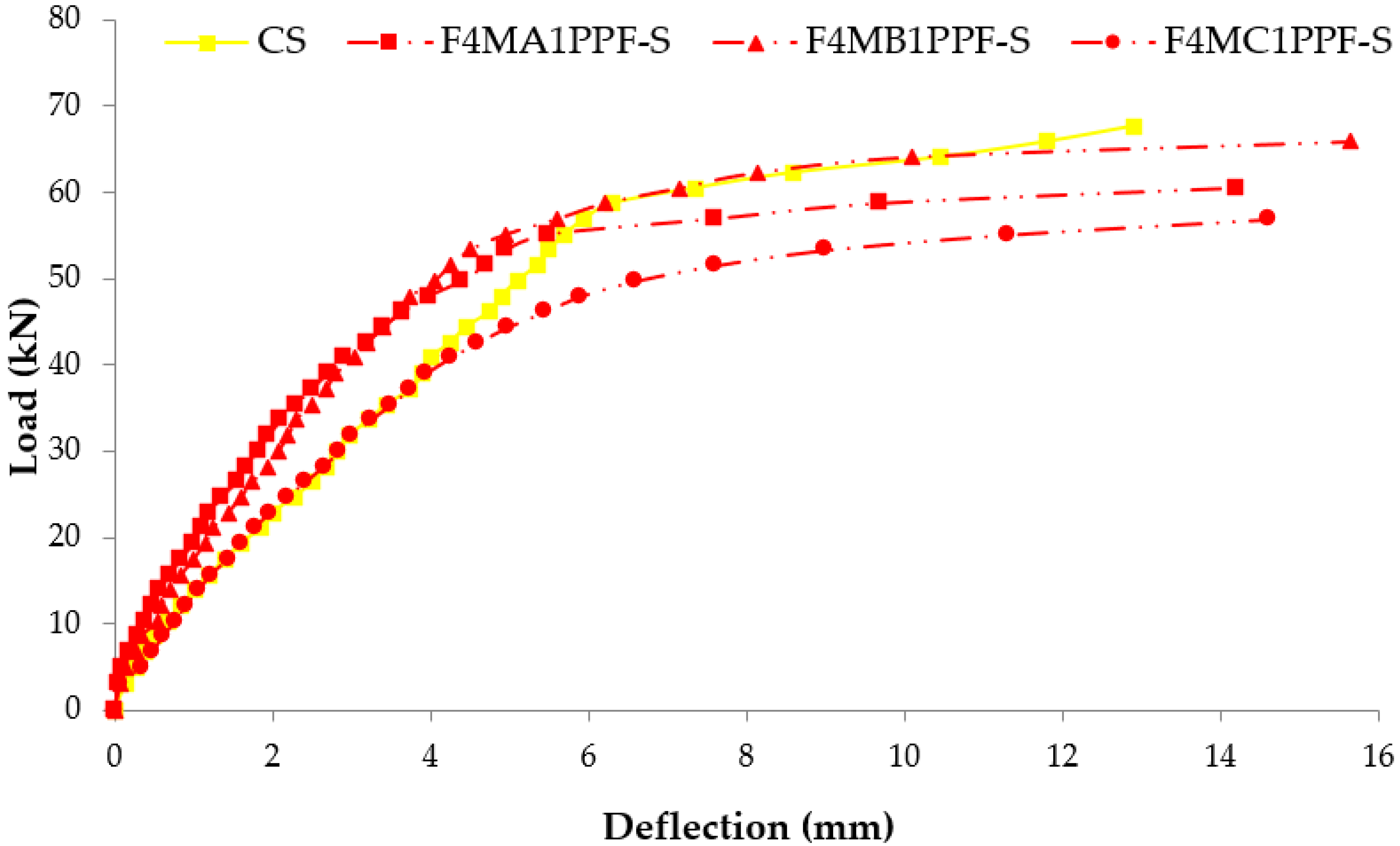
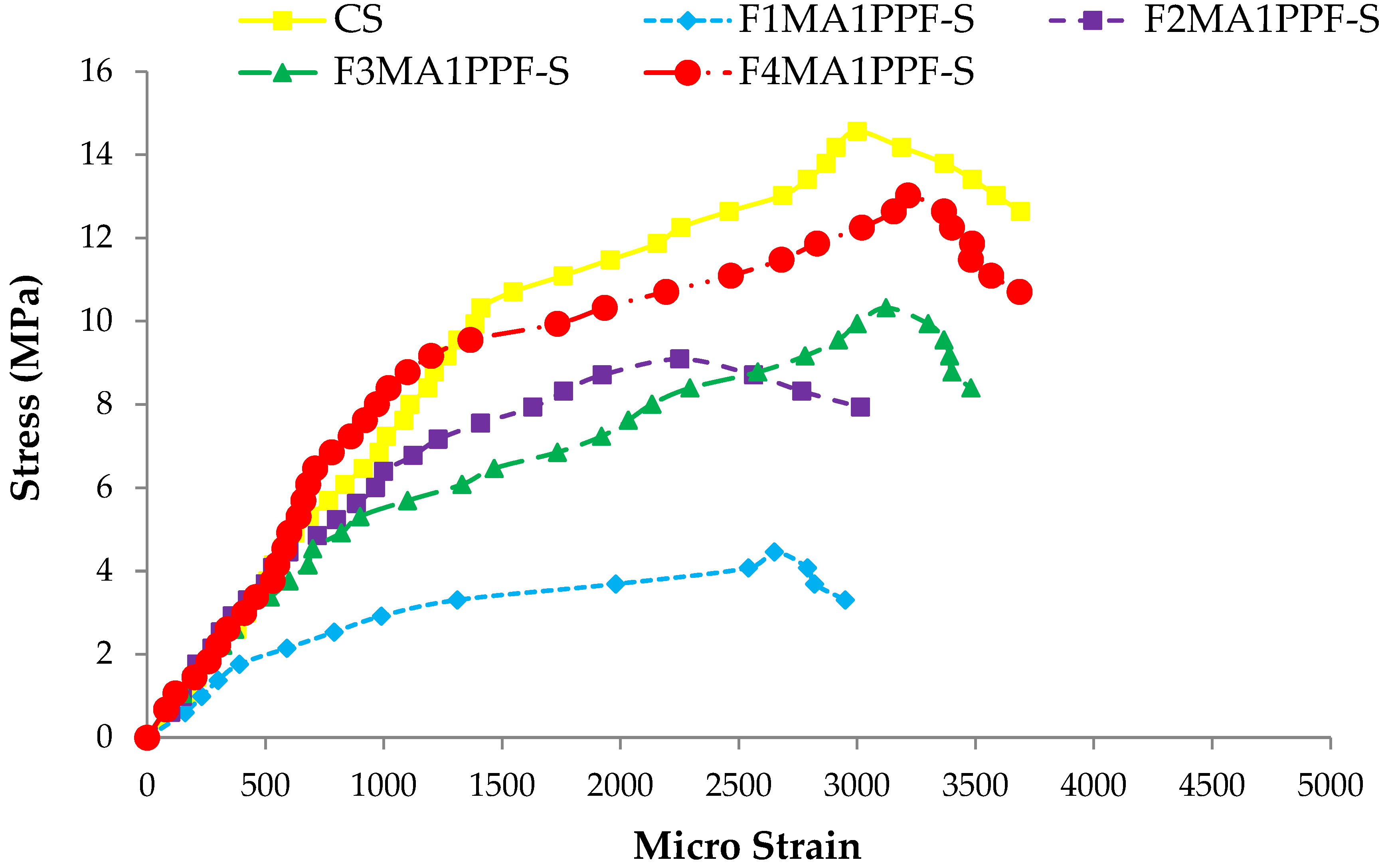


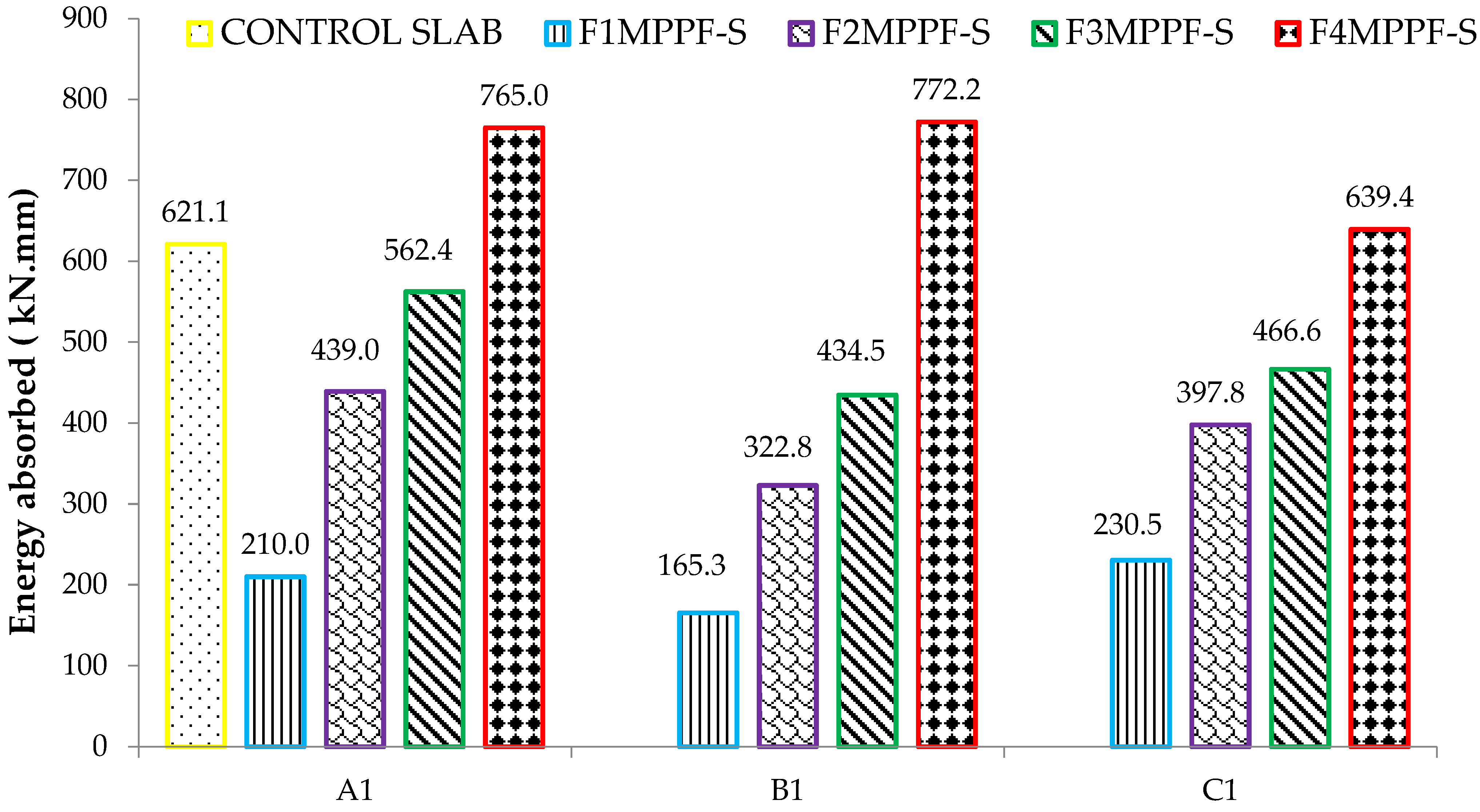
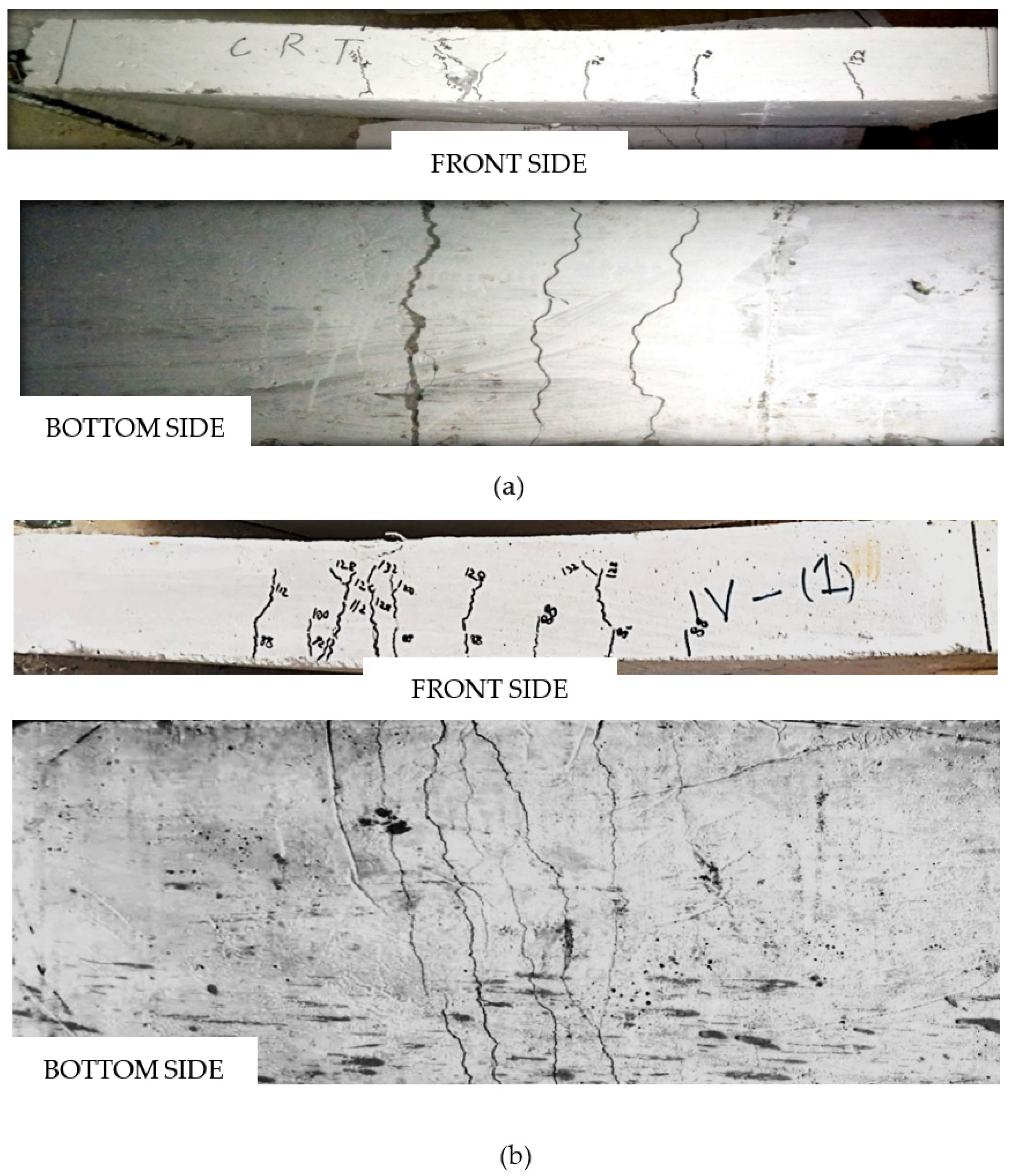

| Parameters | Numerical Values |
|---|---|
| Consistency | 29.34% |
| Soundness | No expansion is seen. |
| 28 days compressive strength | 40.88 MPa |
| Specific gravity | 3.06 |
| Initial setting time | 1 h, 53 min |
| Final setting time | 3 h, 56 min |
| Parameters | Numerical Values | Chemical Composition | Percentage (%) |
|---|---|---|---|
| Appearance | Grey powder | SiO2 | 90–95 |
| Amorphous | SiO2 > 90% | Al2O3 | 4 |
| Specific gravity | 2.2–2.3 | Fe2O3 | 5 |
| Specific surface | 15–30 m2/g | MgO | 5 |
| Mean particle size | CaO | 3 | |
| Dry bulk density (Avg) | 450 Kg/m3 | - | - |
| Parameters | Numerical Values |
|---|---|
| Form | White fibers |
| Density | 0.9 0.01 kg/L |
| Fiber diameter | 15–30 micron |
| Tensile strength | 300–450 MPa |
| Softening point | 160 °C |
| Alkali resistance | 100% |
| Specific surface area | Approx. 200 m2/kg |
| Thermal conductivity | Low |
| Chop length | 6, 9, 12 & 19 |
| Property of SWG MS Mesh | Numerical Values |
|---|---|
| Diameter | 2.6 mm |
| Opening of mesh | 25.4 × 25.4 mm |
| Type | Square-spot welded |
| Weight | 3.273 kg/m2 |
| SWG gauge | 12 |
| Volume | 4.549 × 10−4 m3/m2 |
| Yield strength | 224 MPa |
| Ultimate strength | 294 MPa |
| Sr. No | Specimen Designation | Group | No. of Steel Wire Mesh | Area of Steel (%) | Mix Ratio | W/binder ** Ratio | PPF (%) | SF (%) |  |
| 1 | RCC | Control Slab * | -- | 100 | 1:2:4 | 0.50 | -- | -- | |
| 2 | F1MA1PPF-S | A1 | 1 | 25 | 1:2 | 0.50 | 0.10 | 10 | |
| 3 | F2MA1PPF-S | 2 | 50 | 1:2 | 0.50 | 0.10 | 10 | ||
| 4 | F3MA1PPF-S | 3 | 75 | 1:2 | 0.50 | 0.10 | 10 | ||
| 5 | F4MA1PPF-S | 4 | 100 | 1:2 | 0.50 | 0.10 | 10 | ||
| 6 | F1MB1PPF-S | B1 | 1 | 25 | 1:2 | 0.50 | 0.30 | 10 | |
| 7 | F2MB1PPF-S | 2 | 50 | 1:2 | 0.50 | 0.30 | 10 | ||
| 8 | F3MB1PPF-S | 3 | 75 | 1:2 | 0.50 | 0.30 | 10 | ||
| 9 | F4MB1PPF-S | 4 | 100 | 1:2 | 0.50 | 0.30 | 10 | ||
| 10 | F1MC1PPF-S | C1 | 1 | 25 | 1:2 | 0.50 | 0.50 | 10 | |
| 11 | F2MC1PPF-S | 2 | 50 | 1:2 | 0.50 | 0.50 | 10 | ||
| 12 | F3MC1PPF-S | 3 | 75 | 1:2 | 0.50 | 0.50 | 10 | ||
| 13 | F4MC1PPF-S | 4 | 100 | 1:2 | 0.50 | 0.50 | 10 |
| Sr. No | Type of Slab | Percentage of PPF (%) | 1st Cracking Load in Flexure (A) | Ultimate Load in Flexure (B) | Ductility Ratio (B/A) |
|---|---|---|---|---|---|
| 1 | Control | NIL | 35.41 | 67.66 | 1.91 |
| 2 | F1MA1PPF-S | 0.1 | 13.55 | 20.72 | 1.53 |
| F1MB1PPF-S | 0.3 | 20.72 | 24.31 | 1.17 | |
| F1MC1PPF-S | 0.5 | 22.52 | 26.10 | 1.16 | |
| 3 | F2MA1PPF-S | 0.1 | 26.10 | 42.22 | 1.62 |
| F2MB1PPF-S | 0.3 | 26.10 | 38.64 | 1.48 | |
| F2MC1PPF-S | 0.5 | 28.24 | 37.19 | 1.32 | |
| 4 | F3MA1PPF-S | 0.1 | 28.24 | 47.95 | 1.70 |
| F3MB1PPF-S | 0.3 | 26.45 | 41.22 | 1.56 | |
| F3MC1PPF-S | 0.5 | 33.62 | 46.15 | 1.37 | |
| 5 | F4MA1PPF-S | 0.1 | 35.41 | 60.49 | 1.71 |
| F4MB1PPF-S | 0.3 | 37.18 | 65.86 | 1.77 | |
| F4MC1PPF-S | 0.5 | 40.78 | 56.91 | 1.40 |
Publisher’s Note: MDPI stays neutral with regard to jurisdictional claims in published maps and institutional affiliations. |
© 2022 by the authors. Licensee MDPI, Basel, Switzerland. This article is an open access article distributed under the terms and conditions of the Creative Commons Attribution (CC BY) license (https://creativecommons.org/licenses/by/4.0/).
Share and Cite
Saeed, H.Z.; Saleem, M.Z.; Chua, Y.S.; Vatin, N.I. Research on Structural Performance of Hybrid Ferro Fiber Reinforced Concrete Slabs. Materials 2022, 15, 6748. https://doi.org/10.3390/ma15196748
Saeed HZ, Saleem MZ, Chua YS, Vatin NI. Research on Structural Performance of Hybrid Ferro Fiber Reinforced Concrete Slabs. Materials. 2022; 15(19):6748. https://doi.org/10.3390/ma15196748
Chicago/Turabian StyleSaeed, Hafiz Zain, Muhammad Zubair Saleem, Yie Sue Chua, and Nikolai Ivanovich Vatin. 2022. "Research on Structural Performance of Hybrid Ferro Fiber Reinforced Concrete Slabs" Materials 15, no. 19: 6748. https://doi.org/10.3390/ma15196748







